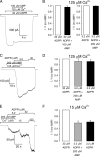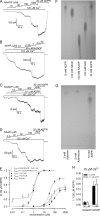Identification of direct and indirect effectors of the transient receptor potential melastatin 2 (TRPM2) cation channel
- PMID: 20650899
- PMCID: PMC2943302
- DOI: 10.1074/jbc.M109.066464
Identification of direct and indirect effectors of the transient receptor potential melastatin 2 (TRPM2) cation channel
Abstract
Transient receptor potential melastatin 2 (TRPM2) is a Ca(2+)-permeable cation channel involved in physiological and pathophysiological processes linked to oxidative stress. TRPM2 channels are co-activated by intracellular Ca(2+) and ADP-ribose (ADPR) but also modulated in intact cells by several additional factors. Superfusion of TRPM2-expressing cells with H(2)O(2) or intracellular dialysis of cyclic ADPR (cADPR) or nicotinic acid adenine dinucleotide phosphate (NAADP) activates, whereas dialysis of AMP inhibits, TRPM2 whole-cell currents. Additionally, H(2)O(2), cADPR, and NAADP enhance ADPR sensitivity of TRPM2 currents in intact cells. Because in whole-cell recordings the entire cellular machinery for nucleotide and Ca(2+) homeostasis is intact, modulators might affect TRPM2 activity either directly, by binding to TRPM2, or indirectly, by altering the local concentrations of the primary ligands ADPR and Ca(2+). To identify direct modulators of TRPM2, we have studied the effects of H(2)O(2), AMP, cADPR, NAADP, and nicotinic acid adenine dinucleotide in inside-out patches from Xenopus oocytes expressing human TRPM2, by directly exposing the cytosolic faces of the patches to these compounds. H(2)O(2) (1 mM) and enzymatically purified cADPR (10 μM) failed to activate, whereas AMP (200 μM) failed to inhibit TRPM2 currents. NAADP was a partial agonist (maximal efficacy, ∼50%), and nicotinic acid adenine dinucleotide was a full agonist, but both had very low affinities (K(0.5) = 104 and 35 μM). H(2)O(2), cADPR, and NAADP did not enhance activation by ADPR. Considering intracellular concentrations of these compounds, none of them are likely to directly affect the TRPM2 channel protein in a physiological context.
Figures







Similar articles
-
Ruling out pyridine dinucleotides as true TRPM2 channel activators reveals novel direct agonist ADP-ribose-2'-phosphate.J Gen Physiol. 2015 May;145(5):419-30. doi: 10.1085/jgp.201511377. J Gen Physiol. 2015. PMID: 25918360 Free PMC article.
-
Nicotinic acid adenine dinucleotide phosphate and cyclic ADP-ribose regulate TRPM2 channels in T lymphocytes.FASEB J. 2006 May;20(7):962-4. doi: 10.1096/fj.05-5538fje. Epub 2006 Apr 3. FASEB J. 2006. PMID: 16585058
-
Synergistic regulation of endogenous TRPM2 channels by adenine dinucleotides in primary human neutrophils.Cell Calcium. 2008 Dec;44(6):604-15. doi: 10.1016/j.ceca.2008.05.001. Epub 2008 Jun 24. Cell Calcium. 2008. PMID: 18572241 Free PMC article.
-
TRPM2: a calcium influx pathway regulated by oxidative stress and the novel second messenger ADP-ribose.Pflugers Arch. 2005 Oct;451(1):212-9. doi: 10.1007/s00424-005-1446-y. Epub 2005 Jun 11. Pflugers Arch. 2005. PMID: 15952035 Review.
-
Regulation of calcium signalling by adenine-based second messengers.Biochem Soc Trans. 2007 Feb;35(Pt 1):109-14. doi: 10.1042/BST0350109. Biochem Soc Trans. 2007. PMID: 17233614 Review.
Cited by
-
Role of TRPM2 in brain tumours and potential as a drug target.Acta Pharmacol Sin. 2022 Apr;43(4):759-770. doi: 10.1038/s41401-021-00679-4. Epub 2021 Jun 9. Acta Pharmacol Sin. 2022. PMID: 34108651 Free PMC article. Review.
-
A residue in the TRPM2 channel outer pore is crucial in determining species-dependent sensitivity to extracellular acidic pH.Pflugers Arch. 2011 Aug;462(2):293-302. doi: 10.1007/s00424-011-0957-y. Epub 2011 Apr 20. Pflugers Arch. 2011. PMID: 21505784
-
The key role of transient receptor potential melastatin-2 channels in amyloid-β-induced neurovascular dysfunction.Nat Commun. 2014 Oct 29;5:5318. doi: 10.1038/ncomms6318. Nat Commun. 2014. PMID: 25351853 Free PMC article.
-
Regulation of Substantia Nigra Pars Reticulata GABAergic Neuron Activity by H₂O₂ via Flufenamic Acid-Sensitive Channels and KATP Channels.Front Syst Neurosci. 2011 Apr 4;5:14. doi: 10.3389/fnsys.2011.00014. eCollection 2011. Front Syst Neurosci. 2011. PMID: 21503158 Free PMC article.
-
Pore collapse underlies irreversible inactivation of TRPM2 cation channel currents.Proc Natl Acad Sci U S A. 2012 Aug 14;109(33):13440-5. doi: 10.1073/pnas.1204702109. Epub 2012 Jul 30. Proc Natl Acad Sci U S A. 2012. PMID: 22847436 Free PMC article.
References
-
- Nagamine K., Kudoh J., Minoshima S., Kawasaki K., Asakawa S., Ito F., Shimizu N. (1998) Genomics 54, 124–131 - PubMed
-
- Perraud A. L., Fleig A., Dunn C. A., Bagley L. A., Launay P., Schmitz C., Stokes A. J., Zhu Q., Bessman M. J., Penner R., Kinet J. P., Scharenberg A. M. (2001) Nature 411, 595–599 - PubMed
-
- Sano Y., Inamura K., Miyake A., Mochizuki S., Yokoi H., Matsushime H., Furuichi K. (2001) Science 293, 1327–1330 - PubMed
-
- Hara Y., Wakamori M., Ishii M., Maeno E., Nishida M., Yoshida T., Yamada H., Shimizu S., Mori E., Kudoh J., Shimizu N., Kurose H., Okada Y., Imoto K., Mori Y. (2002) Mol. Cell 9, 163–173 - PubMed
Publication types
MeSH terms
Substances
LinkOut - more resources
Full Text Sources
Molecular Biology Databases
Research Materials
Miscellaneous

